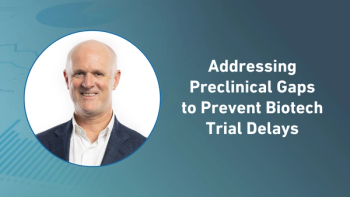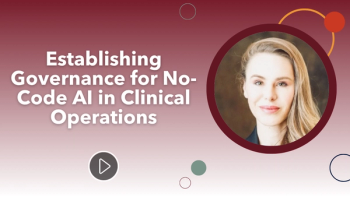
- Applied Clinical Trials-11-01-2021
- Volume 30
- Issue 11
Addressing Digital Trials
Four industry executives share insights during the Media and Analyst Roundtable at Veeva's R&D and Quality Summit Connect.
On October 15, the second day of Veeva R&D and Quality Summit Connect, four industry executives shared insights during the Media and Analyst Roundtable: Digital Trials Speed Path to New Therapies moderated by Veeva’s Vice President, Vault R&D, Jim Reilly. Participants from AbbVie, Labcorp, and GSK discuss the opportunities and challenges digital trials bring to the industry, and the importance of addressing them before fully embracing digital solutions.
Reilly: Digital trials have the potential to bring therapies to patients faster and in a more cost-effective way. Where do you see opportunities for improvement in how trials are run today?
Lorena Gomez, senior director of global study start-up, PRO management, and digital implementation, AbbVie: Every company had started to dip their toes into the digital world, but COVID-19 pushed us all into the proverbial pool. We had to come up with solutions really quickly to keep our studies afloat, now it’s forcing us to be a little bit more forward thinking.
We are asking questions like: ‘How can we make our trials more accommodating for our sites and our subjects?’ That’s where I see the biggest opportunity. With that comes the challenge of making our protocols simpler and easier to execute, while also thinking about studies in a way that facilitates digital approaches. To effectively do that, a strategic, enterprise-level plan is needed.
Mark Morais, president, clinical operations and commercial solutions, Labcorp Drug Development: What we need to think about now is a robust communication platform where we can start to share these learnings. We rushed into the digital space, and we are in danger of increasing complexity in trials. If we don’t understand the challenges, we cannot draw out consistency. That complexity is going to trickle down to manifest itself in terms of site burden. We need to think about the impact to sites, protocol design, and patients—especially in terms of what we’re capturing and how. We have to let digital drive simplicity as we potentially increase all of the disparate data sources.
It’s going to be important that we collaborate as an industry to understand how that patient journey and site relationship is going to change. Historically as partners, we’ve always brought trials to sites. Now, we’re going to find a way to bring patients to trials. This is going to open a new area for therapy of treatment. It’s going to allow us to look at diversity and inclusion in terms of the patients we’re recruiting and the sites that we’re using.
Digital is going to greatly broaden, not only the therapeutic potential, but the opportunities to reach new patients in a more cost-effective way. But if we’re not careful, complexity will derail the opportunity and that will hurt the industry.
Gomez: To that end, there are still many unknowns. It’s the wild west in the digital space and even regulators aren’t necessarily aligned on things such as whether devices need to be labeled or not. There are many different moving parts and a lot of work ahead to pave the path to digital.
Mayank Anand, vice president, and global head, data strategy and management, GSK: There are two components to this. Data and technology, the latter which is going to play a very pivotal role in this entire strategy. The problem is, we don’t have products that are fully mature. There are good solutions where some parts of it are matured, but not entirely. Every organization is looking for multiple solutions to plug in, increasing risk and creating an even more complex environment.
Now imagine you’re going to increase your data by 10-times or 20-times using decentralized technologies like sensors, are we ready for that instant data cleaning? The industry is already struggling with the data we get from trials today. This adds another level of complexity to it.
Data is going to explode in the next couple of years. Instant data cleaning will become a bigger challenge because the expectation will be that if data ingestion is faster, the output has to be faster too. Thinking about data ingestion, in the present world, there are barriers to getting external data. The sharing of data itself is a challenge. Every study brings its own complexity because you have 10 to 15 different external data providers, and everyone uses a different way to inject data. Now just imagine you are making the leap to maybe 20 or 30 different data sources, how would you standardize that?
With technology and data, we must address how we plug in to bring simplicity and a connected architecture. Otherwise, in the next five years we’ll be doing another transformation to address these issues.
Reilly: What can organizations do to advance to a more holistic way that drives a better trial outcome?
Anand: One thing, which is a requirement, is the clinical hub. This concept has been around for some time, but with the creation of more integrations and data in different silos, there is a need for a better approach. I think the future lies in having a single source of ingestion and aggregation. This is difficult to accomplish because at present, we are not able to standardize. It’s very important that standardization is at the core among all of this if we really want to simplify trials.
As an industry, companies should stop customizing tools according to protocols. Don’t customize because you have some specific requirements—adopt and adapt the tool the way it is. I think that will be a more efficient way to bring simplicity to trials. This will not only help you, but I can guarantee investigators and patients will benefit because they actually face the complexity of these customized systems.
Morais: I think the customization of systems creates a big drain in terms of how sites are utilizing the tools. This opens itself up for future issues in how we aggregate data, and the quality of the data itself. I think the one thing we need is not an entirely consistent strategy, but alignment as an industry on an end-to-end strategy for platform management and data aggregation, and the governance around that.
If we’re not careful, too much standardization will stifle innovation. Innovation is allowing us to transform the way that we work right now, but it’s also adding complexity.
We have to find that delicate balance between standardization, while still driving innovation and change. We’ve seen it in the post-COVID world as we all rush to create new strategies of how we were going to drive trial continuity and patient monitoring. We all created bespoke solutions, most of which are working great right now, but you’re starting to see those inconsistencies.
We’re also creating a great amount of learning. We need to take those learnings and share it as part of that end-to-end strategy and allow it to influence what we do next.
Reilly: When you look at regional guidelines and country-specific concerns, could you share your perspectives on how, as an industry, we can help overcome that
so these tools can be used more broadly?
Gomez: There are two pieces to this. First, there’s the upfront strategy around how the digital pieces of your program fit together from a data perspective. Companies need to assess these tools to ensure they can gather the needed information and bring all the data together to use it.
Then there’s how to operationalize and implement the tool. Can this even be done in the countries that you’re going to? Having that intelligence, a well-defined infrastructure, an overarching strategy–both from a data perspective and operational implementation perspective–are of critical importance to drive success.
Even regulators are still working on figuring out this space. I don’t know that it’s possible right now to guarantee success, but as an industry we have to continue communicating with one another. As several of our speakers have underscored already, sharing best practices and setting standards as an industry to eliminate all these obstacles will be critical.
Morais: As we start to collect more information and going direct to patients through wearables and real-time access, data privacy practices and regulations have not caught up yet. What we’re going to find is, the digital space is innovating and transforming faster than digital patient’s rights are. We’ll need to understand how that’s going to influence our ability to collect the data—what data we can collect, the timing of that data, and how it’s utilized.
Anand: EU data protection doesn’t allow ease in using data centers outside the EU in relation to EU data protection law. This sometimes creates a bottleneck for organizations adopting technology that don’t have data storage within the EU.
As an industry, we must change our mindset. One side is changing and evolving versus the other side still wearing the old hat. One recent example is where we did some sessions for the FDA to understand how artificial intelligence and machine learning works into the clinical space, the uses, the advantage, and how they can improve their own ways of inspecting data. I think that’s the bigger problem, regulation.
Miranda Schmalfuhs is an Assistant Editor for Applied Clinical Trials. She can be reached at
Articles in this issue
almost 4 years ago
Currency of Patient Engagement: Changing Tidesalmost 4 years ago
Biopharma-Academic Collaborations in 2021almost 4 years ago
Taking DCTs to the Next Levelalmost 4 years ago
A New Era for Translational Researchalmost 4 years ago
Applied Clinical Trials November 2021 Issue (PDF)almost 4 years ago
European Drug Repurposing: An Updatealmost 4 years ago
Increasing Adherence With Dosing Remindersalmost 4 years ago
FDA Acknowledges Hurdles in Utilizing Real World Dataabout 4 years ago
The Answer to Streamlined Clinical Trialsover 4 years ago
Accelerating Research Site OperationsNewsletter
Stay current in clinical research with Applied Clinical Trials, providing expert insights, regulatory updates, and practical strategies for successful clinical trial design and execution.






.png)



.png)



.png)
.png)
